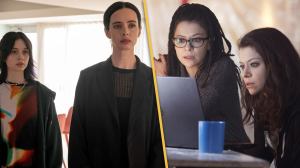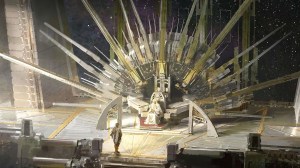Orphan Black stands as a landmark of modern science fiction, a series that blended high-concept thrills with a deeply resonant character study. Its premise was ambitious from the start, throwing viewers into a world of illegal human cloning and a shadowy corporate conspiracy that spanned generations. The show’s entire intricate narrative rested on the shoulders of its lead, Tatiana Maslany, who delivered one of television’s most celebrated performances. Her ability to seamlessly embody more than a dozen distinct clones, each with a unique psychology and physicality, was the emotional anchor that made the unbelievable feel real.
Videos by ComicBook.com
While the intricate mystery of Project Leda propelled the plot of Orphan Black forward, the show’s true power and lasting appeal came from its profound emotional core. At its heart, Orphan Black was a story about the messy, fierce, and unbreakable bonds of sisterhood. The “Clone Club,” a found family of women who were never supposed to meet, fought together for their right to exist as individuals, a narrative hook that grounded the show’s most fantastic elements. As a result, the series consistently explored powerful questions about identity, nature versus nurture, and bodily autonomy, making its most memorable episodes the ones where the high-stakes plot converged with character-defining moments.
10) “Governed As It Were by Chance” (Season 2, Episode 4)

“Governed As It Were by Chance” brilliantly pivots from the season’s frantic pace to deliver a deeply resonant chapter focused on character and mythology. The episode achieves this by splitting its focus between two crucial journeys. One path follows a newly escaped Helena, leading her to a roadside bar where a violent brawl gives way to a surprisingly tender dance with a stranger, Jesse (Patrick J. Adams). This sequence provides a startling look at the woman behind the monster. The second journey sends Sarah Manning searching for answers, only to have her collide with a ghost from her past, Cal Morrison (Michiel Huisman).
The introduction of Cal is a monumental development, confirming him as Kira’s biological father and grounding Sarah’s struggle in a tangible reality outside the clone conspiracy. His existence immediately complicates the show’s core themes, forcing Sarah to reconcile her dangerous present with the life she once had. Helena’s storyline is equally impactful. Her brief, gentle connection with Jesse is the first time the audience sees her not as an antagonist or a broken weapon, but as a vulnerable person capable of connection. The episode masterfully uses these quiet revelations to expand the emotional stakes for its two central clones.
9) “To Right the Wrongs of Many” (Season 5, Episode 10)

Rather than ending on a final battle, “To Right the Wrongs of Many” concludes the series with a quiet, powerful, and deeply emotional hour focused entirely on the aftermath of the war. The fight is over, but Sarah is adrift, struggling with the trauma of her past and the grief of losing her mother. She wrestles with the weight of her future, uncertain of where to go next. This sets the stage for the show’s most important scene, a final gathering of the core sisters.
In the backyard, Alison, Cosima, and Helena confront Sarah’s pain not with easy answers but with shared vulnerability. They confess their own fears and failings as mothers and as people, reminding her that she is not alone in her brokenness. This raw conversation becomes the ultimate expression of the show’s central thesis about the power of sisterhood. Because of that, the finale closes with the clones finally free, each embarking on a new chapter with their futures their own, providing a perfect poignant ending.
8) “The Scandal of Altruism” (Season 4, Episode 6)

“The Scandal of Altruism” delivers one of the most gut-wrenching betrayals in the entire series. In a desperate bid to save Cosima the clones make a deal with Evie Cho (Jessalyn Wanlim), a Prolethean-affiliated clone, giving her access to the original Leda genome, Kendall Malone (Ksenia Solo). Evie reveals her true colors in a stunning act of cruelty by having her operative, Detective Duko, execute Kendall and incinerate her body right in front of a horrified Cosima.
Evie’s chilling monologue, where she declares the clones “obsolete technology” and “Betamax,” reframes the central conflict and establishes her as a ruthless new antagonist. The loss of Kendall is a devastating blow. She was the key to a cure, but she was also Siobhan’s (Maria Doyle Kennedy) mother and a tangible link to the clones’ past. This episode presents a brutal examination of hope and loss, demonstrating the immense cruelty of a mindset that views human life as disposable.
7) “History Yet to Be Written” (Season 3, Episode 10)

“History Yet to Be Written” is a masterclass in suspense and emotional whiplash, ending the third season with a series of devastating blows. The episode follows the Leda clones’ desperate attempt to secure Kendall Malone, the original genome. The plan goes disastrously wrong, culminating in one of the show’s most shocking moments. Delphine Cormier (Evelyne Brochu), now a director at Dyad, is shot in a parking garage by an unseen assailant, leaving her fate ambiguous and viewers heartbroken.
The episode expertly juggles multiple storylines, from Alison and Donnie (Kristian Bruun) trapping the Castor clone Rudy (Ari Millen) to Rachel discovering her supposedly dead mother is still alive. Sarah returns home to find her mother, Mrs. S (Maria Doyle Kennedy), enjoying a quiet moment with Kendall, grounding the emotional stakes. However, throughout the episode, the Neolution threat looms larger, reminding viewers that the clones’ nightmare is far from over.
6) “Nature Under Constraint and Vexed” (Season 2, Episode 1)

The second season premiere throws Sarah Manning directly back into the fire, picking up moments after the chaotic first season finale. Desperate to find her missing daughter, Kira, and her foster mother, Mrs. S, Sarah’s search leads her to a violent confrontation with two menacing Neolution operatives in a diner. The brutal fight sequence immediately establishes a more dangerous and aggressive tone for the season.
The episode masterfully re-establishes the stakes while expanding the conspiracy. We see Rachel, the pro-clone antagonist, exerting her corporate power, and Alison struggling with the guilt surrounding her daughter Aynsley’s health crisis. “Nature Under Constraint and Vexed” successfully avoids a slow start by dropping the audience and its hero into the middle of the action, signaling that the threats are bigger and the fight for survival is more desperate than ever.
5) “Natural Selection” (Season 1, Episode 1)

A great pilot must establish a compelling mystery and give the audience a protagonist worth following. “Natural Selection” achieves both with stunning efficiency. The opening scene is a gut-punch, as street-smart grifter Sarah Manning witnesses a woman who looks exactly like her, Beth Childs, calmly step in front of an oncoming train. Sarah’s impulsive decision to steal Beth’s identity in a bid to fund a new life for herself and her daughter is the catalyst that throws her into a world of paranoia and conspiracy she could never have imagined.
The first episode moves with a relentless pace, brilliantly establishing the immediate stakes. Sarah is a flawed and frightened woman in over her head, and her clumsy attempts to navigate Beth’s life as a cop, complete with a suspicious partner, Art Bell (Kevin Hanchard), and a grieving boyfriend, Paul Dierden (Dylan Bruce), create an almost unbearable tension. The hour ends with another shocking clone reveal, a perfect hook that immediately solidifies the show’s core premise that danger and discovery lie around every corner.
4) “Certain Agony of the Battlefield” (Season 3, Episode 6)

In “Certain Agony of the Battlefield,” the once morally ambiguous Paul receives a heroic and heartbreaking conclusion. Trapped in the Castor military compound with Sarah, Paul sacrifices himself to help her escape and to destroy Dr. Virginia Coady’s (Kyla Harper) research, as she planned to weaponize the Castor genetic defect. After being stabbed multiple times, Paul uses his final moments to detonate a grenade, taking out a significant portion of the base and Coady’s horrific work with it.
Paul’s final stand becomes a powerful moment of redemption, revealing his loyalty was ultimately to the soldiers he commanded. He desperately wanted to cure the Castor “brothers,” not exploit them. Consequently, his death is one of the most impactful in the series, not just for its explosive finality but for the clarity it brings to his character arc. Plus, the brutal and poignant episode underscores the tragedy of the Castor clones, framing them as damaged soldiers and connecting their story directly to the Leda clones’ fight for autonomy.
3) “Things Which Have Never Yet Been Done” (Season 2, Episode 9)

Season 2 Episode 9 of Orphan Black permanently alters the course of the series with a shocking twist that no one saw coming. While much of the hour follows Cosima’s deteriorating health and Rachel’s cold preparations to harvest Kira’s bone marrow, the story’s most significant event belongs to Alison’s husband, Donnie Hendrix (Kristian Bruun). Convinced that Dr. Leekie (Matt Frewer) and the Dyad Institute are a threat to his family, a paranoid Donnie confronts him in his car. In a moment of sheer incompetence, Donnie accidentally discharges his gun, killing the high-ranking Neolutionist instantly.
The accidental death of a major character completely redefines Donnie’s role in the series. He is no longer just a bumbling, suspicious monitor but an active, panicked participant in the conspiracy. This event transforms him and Alison into a chaotic Bonnie and Clyde duo, providing some of the show’s most beloved comedic subplots in later seasons. The episode is a perfect example of Orphan Black’s ability to blend tragedy and absurdity, using an accidental murder to pivot a supporting character into a fan-favorite.
2) “Endless Forms Most Beautiful” (Season 1, Episode 10)

The first season finale, “Endless Forms Most Beautiful,” is a flawless hour of television that pays off every plot thread while introducing explosive new stakes. The episode forces Sarah to choose between her found family and a life on the run with her daughter, Kira (Skyler Wexler). This culminates in a heart-stopping confrontation with the unstable Helena, who mistakenly believes Sarah sold her out to the Proletheans. In a moment of self-defense, Sarah shoots her twin just as she learns Helena has the key to their origins.
This episode reveals the stunning truth that the clones are patented property of the Dyad Institute, a revelation that redefines their entire struggle, as a personal fight for survival becomes a war for their very identity and freedom. The finale also ends on a perfect cliffhanger. Kira and Mrs. S (Maria Doyle Kennedy) are missing, their apartment has been ransacked, and Sarah is left completely alone, her world shattered. It solidifies Orphan Black as essential viewing and represents the moment the series’ full potential was unleashed.
1) “By Means Which Have Never Yet Been Tried” (Season 2, Episode 10)

The second season finale, “By Means Which Have Never Yet Been Tried,” is a powerhouse of plot twists and emotional payoff. After escaping the Dyad Institute, Sarah, Cosima, Alison, and a newly welcomed Helena gather at Felix’s (Jordan Gavaris) apartment. This leads to the legendary clone dance party, a moment of pure joy that serves as a profound emotional release for the characters and the audience. For a brief moment, the conspiracy fades away, allowing the sisters to simply exist together and celebrate their connection.
That moment of peace is shattered by the episode’s massive cliffhanger reveal of Project Castor, a separate military-run cloning program that created a line of male clones. The introduction of Mark (Ari Millen) as another manufactured human being completely redefines the scope of the conspiracy. This final reveal proves that Leda was not the only experiment and that the battle for genetic ownership is far larger than the sisters ever imagined. The twist masterfully broadens the mythology and sets the stage for a new and even more complex conflict.
What is your favorite episode of Orphan Black? Let us know in the comments!









